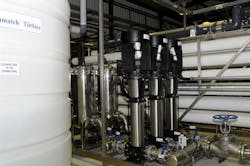What is Reverse Osmosis (RO)?
Reverse Osmosis (RO) is a type of filtration that uses a semi-permeable, thin membrane with pores small enough for pure water to pass through, while rejecting larger molecules and other contaminants.
Water flows from the more concentrated side of the RO membrane to the less concentrated side to provide clean drinking water. The fresh water produced is called the permeate and the concentrated water left over is called the waste or brine.
Reverse osmosis is used to produce highly purified water for drinking water systems, industrial boilers, food and beverage processing, cosmetics, pharmaceutical production, seawater desalination, and other applications. It has been a recognized technology for more than a century.
RO consists of the utilization of filtration systems which remove dissolved ions from water. Osmosis draws water to water with higher salt content and this process removes the ions from the water by applying pressure with the usage of pumps and semi-permeable membranes.
How does the reverse osmosis (RO) system work?
An RO system removes sediment and chlorine from water with a prefilter before it forces water through a semipermeable membrane to remove dissolved solids.
The majority of the commercially manufactured RO membranes are made from cellulose acetate, polysulfonate, and polyamide.
Once water exits the RO membrane, it passes through a postfilter before the drinking water enters a faucet.
An RO system also includes other types of filtration, sometimes being made up of between 3 to 5 stages of filtration.
Each type of system contains one or more of the following filters:
- Sediment filter: Reduces particles like dirt, dust, and rust;
- Carbon filter: Reduces volatile organic compounds (VOCs), chlorine, and other contaminants; and
- Semi-permeable membrane: Removes up to 98% of total dissolved solids (TDS).
What are the benefits of RO?
RO operates at a comparatively low temperature and can be employed in various applications, such as: desalination, wastewater treatment; reclamation of minerals; concentration of whey and other food products; and finally, the purification of water.
In recent years, RO has been used increasingly in making processed water for dialysis in hospitals and for certain cosmetics and drugs by pharmaceutical manufacturers.
A major issue in operating RO systems is concentration polarization, or fouling, which is the gradual build up of rejected solute on the feed side, adjacent to the membrane. A flush cycle is often used to reduce this build up.
Reverse Osmosis and Wastewater
An RO system sends water with rejected contaminants down the drain as wastewater, unlike other filters that trap contaminants. As water flows through, it's divided into two streams; One stream carries the filtered water to a dedicated faucet and the other stream carries the removed salts, dissolved pollutants, and minerals to the drain.
The wastewater carries rejected contaminants from an RO system to the drain, so the water is technically not a waste, after all.
